
Japanese food is one of the main expressions of the culinary art developed in the Japanese country. Traditional cuisine is also called in the Japanese language nihon-ryōri or washoku to identify precisely the cuisine prior to the Meiji period, in stark contrast to the yōshoku cuisine (that is, “Western cuisine”) which spread throughout the nation of Japan following the abolition of the Meiji period. “Closed country” (sakoku) following the Meiji Restoration. During the latter period, many dishes of Western origin were imported and adapted to local tastes. Japan has historically helped shape life through technological advances but until recently it seemed to fail to make inroads into Western culinary tradition. Now the situation has changed a lot, and Japanese sushi bars and restaurants are widespread and appreciated in the western land.
Contrary to what many may paradoxically think, in distant Japan sushi is not eaten every day, food in Japan is never just a simple dish, but is linked to history, seasonality and a very strong aesthetic component of the dish.
Today some of the specialties of Japanese cuisine, even less known in the West, will be described one by one.
Summary
- Main ingredients and dishes
- Japanese cuisine with TEXOLIQ
- History of Japanese cuisine
- Traditional Japanese cuisine
- Japanese cuisine meals
- Traditional culinary techniques of Japanese cuisine
- Japanese cuisine and aesthetics of dishes
- Sushi
- Tofu
- Tempura
- Miso soup
- Wonton soup
- Ramen
- Udon
- Onigiri
- Gyoza
- Soba
- Curry rice
- Yakisoba
- Sashimi
- Yakitori
- Natto
- Oden
- Tamagoyaki
- Donburi
- Sukiyaki
- Tonkatsu
- Nikuman
- Ganmodoki
- Kaisen-don
- Unagi
- Mentaiko
- Nikujaga
- Kaiseki
- Okonomiyaki
- Chawanmushi
- Edamame
- Shabu shabu
- Takoyaki
- Yakiniku
- Dorayaki
- Mochi
- Taiyaki
- Wagashi
- Konpeito
- Melon pan
- Daigakuimo
- Kasutera
- Japanese cuisine drinks
Main ingredients and dishes
One of the main ingredients of Japanese cuisine is rice (always first choice and rigorously fresh), but fish, vegetables, pasta and legumes are also widespread, usually seasoned with the different sauces and spices of local tradition. In the past, meat was completely absent from traditional Japanese cuisine, but present in some dishes of foreign origin. The best known dishes are: sushi, tofu, tempura, miso soup, wonton soup, ramen, udon, onigiri, gyoza, soba, curry rice, yakisoba, sashimi, yakitori, natto, oden, tamagoyaki, donburi, sukiyaki, tonkatsu, nikuman, ganmodoki, kaisen-don, unagi, mentaiko, nikujaga, kaiseki cuisine, okonomiyaki, chawanmushi, edamame, shabu shabu, takoyaki and yakiniku. Drinks include sake and green tea, and there is a good variety of desserts, including: dorayaki, mochi, taiyaki, wagashi, konpeito, melon pan, daigakuimo and kasutera.
The clear difference with western cuisine is that there is no concept of first course, second course, side dish, fruit and dessert. In fact, usually all the foods that make up the meal are brought to the table at the same time, which are consumed without a pre-established order and at the discretion of the diner. Many dishes are convivial, and in homes they are cooked with a portable stove directly on the table and the diners sometimes serve themselves directly from the pot. The frying technique is widely used in various ways, the “heaviness” of which is balanced by a large amount of vegetables present.
Japanese cuisine with TEXOLIQ
Japanese cuisine is considered one of the healthiest, most complete and balanced, both in the East and in the West, but without the knowledge of the recipes and the tools suitable for preparation, it is impossible to replicate at home.
The tools for preparing Japanese cuisine, which has also been listed as a UNESCO oral and intangible heritage of humanity since December 2013, are not always easy to find with high quality. Relying on the TEXOLIQ preparation kit is the best choice for approaching Japanese cuisine.
For years now, Japanese cuisine has also become part of Western habits: lunches and dinners based on maki, temaki, uramaki, gunkan, hosomaki, oshizushi and sushi green satisfy appetites more and more often. But what is really known about Japanese food culture?
History of Japanese cuisine
Japanese cuisine as it is known today comes from a long history. The Japanese archipelago is made up of many islands that stretch over 3,650 kilometers. This geographical feature has determined that Japanese cuisine varies greatly from north to south, giving rise to a multitude of styles of Japanese cuisine, obviously each style is typical of its area of origin. Nonetheless, these types of Japanese cuisine have gradually been marked by changes due to the innovations of foreign civilizations that have brought different cooking techniques and new ingredients.
In the Jōmon period (also known as the prehistoric period), the first Japanese settlements dating back to the Stone Age based all their diet on seafood and rice. In the Kofun period (from the 3rd to the 7th century) total chaos reigns; in fact, on the one hand, with the diffusion of the Buddhist religion, the inhibition of meat consumption was introduced (this is because Zen Buddhism is based on the valorisation and respect of any form of life, and this determined the assumption of a style of purely vegetarian life) up to the Meiji Restoration, and on the other hand some sources suggest a well-defined picture of food habits only starting from the moment of formation of the Yamato dynasty and therefore there are not many certainties in this regard.
During the Heian period (which goes from 794 to 1182), the sources on Japanese cuisine and on the diet of the Japanese became increasingly conspicuous. With the advent of the Edo period (which goes from 1603 to 1868), a significant number of varieties of foods and specialties of Japanese cuisine were introduced. During the Meiji period (which goes from 1868 to 1912) various specialties of foreign origin will be added which will further enrich the list of dishes of Japanese cuisine.
Post war period
After World War II, Japan became home to a widespread fast-food culture. During the 1950s, the Tokyo Yoshinoya restaurant spread nationwide by exploiting a chain of restaurants spread throughout the country, obviously of American origin, but continuing to serve traditional Japanese cuisine. The large American fast food chains such as the well-known McDonald’s and Burger King also began to take hold in Japan, imitating which later Japanese restaurant chains such as MOS Burger and Freshness Burger were born, offering customers various combinations of products typical of Japanese cuisine and American food.
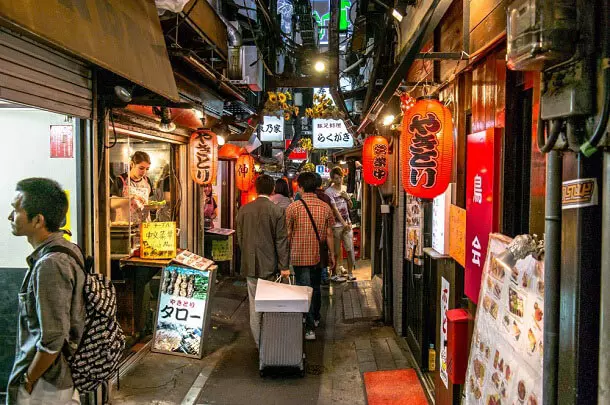
Traditional Japanese cuisine
In addition to the list of Japanese cuisine used by modern Japanese families, there are different types of fine and traditional Japanese cuisine. These types of traditional Japanese cuisine are part of Japanese haute cuisine, and are:
- Japanese cuisine yusoku is the celebratory cuisine of the Japanese nobility, popular in the period from 794 to 1185, known as the Heian period. Japanese yusoku cuisine is still practiced today in Kyoto prefecture which is located in the Kinki region on the island of Honshū.
- Honzen Japanese cuisine is considered the formal cuisine of the Edo period and was especially widespread among the samurai during the Muromachi period (which runs from 1336 to 1573). It subsequently fell into disuse from the Meiji period onwards. Today it is possible to find it, with the name of Japanese cuisine sawachi, in the prefecture of Kōchi, on the island of Shikoku.
- Japanese cuisine cha kaiseki is the cuisine used during tea ceremonies and has spread especially among craftsmen, merchants and artists. This type of cuisine is the most common type of typical Japanese cuisine.
The vast majority of these types of Japanese cuisine followed the principle of ichijū sansai (which is soup with three other dishes) until the Edo period, but now they consist of more than a dozen different dishes. There is also a vegetarian Japanese cuisine originally known as shojin Japanese cuisine, following the imposition of vegetarianism by the Zen Buddhist religion. There are also a myriad of traditional local cuisines in Japan. In addition to this, there are many local specialties such as chinmi, which are local cuisines with a delicate taste, which include among their dishes dishes based on rice, fish and seafood caught on the spot and prepared according to indigenous recipes.
Main traditions
In traditional Japanese cuisine, many dishes, sweets and drinks are strictly linked to local festivals, some examples are: zōni, which is nothing more than a rice soup with mochi and is traditional for the New Year period; the dishes of the osechi cuisine, also linked to the traditions of Japanese cuisine in the celebrations for the coming new year, served on a particular lacquered container called jūbako; and finally the custom of eating chicken during the Christmas period.
In traditional Japanese cuisine, during the period of the “seven herbs festival” which takes place on January 7 (in Japan it is jinjitsu day), it is traditional to consume a rice soup seasoned with seven herbs which takes the name of nanakusa-gayu; on the other hand, during the Setsubun period, ehomaki (a rice-based roll that must be swallowed in one bite) is eaten; and again, during the Kagami Biraki period it is customary to eat kagami mochi. Moving on to drinks, amazake and amacha are drunk respectively during the periods of Hinamatsuri and Hana matsuri. Finally, the kashiwa-mochi and chimaki sweets are typical of the “children’s day”, while the chitose ame (also called “thousand-year candy”) is a sweet that is enjoyed during the Shichi Go San period.

Japanese cuisine meals
In Japanese cuisine there are three main meals:
- breakfast, which can be both traditional and western;
- lunch, which is often eaten quickly in the workplace or at school, and is usually made up of pre-packaged or previously home-prepared meals of Japanese cuisine and transported in special boxes for food (in Japan they are called bento);
- dinner, more respectful of Japanese tradition. It is customary to consume it in small restaurants, sushi bars or in yatai which are the typical street stalls.
In addition to the three main meals, there is the most commonly oyatsu afternoon snack. It consists of a non-alcoholic drink which can be hot or cold and snacks called o-kashi which can be sweet, savoury, industrial or artisanal. This custom of Japanese cuisine dates back to just before the Edo period.
Breakfast
As mentioned, Japanese breakfast is generally of two types: traditional or western.
The traditional Japanese breakfast can be compared, due to its nutritional values, to a real lunch. In addition to rice, it can include miso soup, tofu, pickles such as radishes or plums and fish, both raw and smoked. An egg is often beaten over the rice with soy sauce added to give it a distinctive golden color, while nori seaweed is used to wrap the rice and eat it.
Western breakfast consists of eating corn flakes and drinking milk, hot chocolate or fruit juice. Slices of toasted bread with butter and jam, eggs or chopped vegetables are usually eaten, accompanied by coffee and orange juice. This breakfast is more common in families made up of young couples. Often the western breakfast is preferred to the traditional one as it requires less time to be prepared, decreasing the duration of the meal.
This strong distinction between traditional breakfast and Western breakfast is seen among traditional Japanese hotels that exclusively serve traditional breakfast. Instead, Western-style hotels and restaurants instead offer customers a choice between the two types of breakfasts common in Japan.
Lunch
Lunch in Japan is much lighter than dinner and changes radically from person to person depending on daily commitments (such as work or school). Usually, for those who stay at home it is generally composed of a traditional dish of Japanese cuisine, while those who work often resort to pre-packaged dishes (such as onigiri or bentō) or go to the sushi bars at the workplace. A Japanese restaurant at noon almost always offers some fixed-price menus called ranchi-setto.
The traditional bentō is a take-away meal popular especially among teenagers, consisting of rice, fish and/or meat and pickled or cooked vegetables. It is prepared at home and then transported or bought in street stalls, sushi bars, restaurants, supermarkets or special stores. The bentō bought at railway stations is called ekiben, and varies according to the station. As per the tradition of Japanese cuisine, the foods that make up the bento are arranged in such a way as to create an aesthetically pleasing and pleasant whole. The Japanese often call it obentō, with the honorific prefix o added. The origins of bentō coincide with the Heian period (which goes from 794 to 1182), when the first onigiri were prepared.
Dinner
In Japanese cuisine the main meal is dinner, in fact it is the most respectful meal of the Japanese tradition, during which all family members eat together. The typical menu follows the “one soup and three courses” philosophy, where the main course consists of rice or a soup, plus three side dishes that form the side dish. The latter, in Japan, are called okazu and are generally served in small quantities. Japanese cuisine pays particular attention to the variety of tastes, colors and forms of preparation, choosing the most suitable side dishes from the following categories:
- namamono, ie something raw (often strips of sashimi or vegetables);
- agemono, ie something fried (usually tempura);
- mushimono, ie something steamed;
- nimono, ie something boiled;
- tsukemono, ie something in brine;
- yakimono, ie something grilled;
- sumono, ie something with vinegar.

Traditional culinary techniques of Japanese cuisine
Japanese cuisine dishes are usually classified according to the cooking technique in which the ingredients are cooked. This classification is important when a meal is part of a particular type of cuisine (the aforementioned kaiseki, honzen or shojin cuisines, for example). In these meals, each dish of Japanese cuisine has a specific position in a pre-set order, and this particularity is respected until the meals are served on the table.
The choice of ingredients is often at the discretion of the sushi chef (whose choices are mainly dictated by the seasonality of the ingredients), but the type of cooking technique to be used for the preparation is imposed by the type of tradition that one intends to follow for that particular dish. Often the names of the dishes contain the name of the technique used (for example yakitori, where the prefix yaki indicates something grilled or embers); the suffix mono (such as yakimono) is added to side dishes instead.
The flavor of glutamate called umami, identified as one of the five fundamental tastes in 1908 by the chemist Kikunae Ikeda, is almost always present in Japanese cuisine. It is found in stews, soups and pot-cooked dishes often accompanied by a broth over soy sauce, as well as being used for cooking other main dishes such as fish, shellfish and mushrooms.
Cutting and shredding techniques
In Japanese cuisine, cutting and mincing food plays a role of fundamental importance, and it must be done so that the single bite can be easily grasped with chopsticks. For this reason, the TEXOLIQ sushi kit includes a knife useful for all the cutting techniques and procedures typical of Japanese cuisine.
There are a number of cutting techniques, including: arare-giri (which is diced), hangetsu-giri (which is crescent-shaped), sainome-giri (which is another type of dicing), sasagaki (which is shavings), sen -giri (i.e. in strips), tanzaku-giri (i.e. in sticks), wa-giri (i.e. in slices) and again hyōshigi, the latter reserved for legumes, which are given a rectangular or squared shape.
There are various decoration techniques used to make the ingredients similar to each other, for example, to flowers and they are used above all by Japanese mothers to decorate their children’s bento boxes, composing characters with food, which are called kyaraben (from the words character and bentō).
Another traditional fruit carving art is called mukimono. In practice it consists in obtaining from fruit or vegetables such as Japanese radish, carrots and aubergines, traditional figures of Japanese culture such as fans or the typical flowers.

Japanese cuisine and aesthetics of dishes
If you want to have a full Japanese-style dinner, then you need to know that according to Japanese culture, the meal has a very important value, which goes beyond the simple nutritional need.
For this reason, food must above all be beautiful to look at, even before it is cooked. Moritsuke is the word that indicates the Japanese art of plating and which takes into account an obsessive attention to color, shape and space.
Already from the preparation of Japanese cuisine dishes we must keep in mind that aesthetics play a role of fundamental importance. The slices must be cut in a regular manner, the garnishes must have the right colours, the crockery must be suitable for the dish that will be presented. Or again, the dishes shouldn’t be filled to the brim, but leave at least a third empty to create a stimulus that reaches from the eye to the palate, making you want to fill the void with fullness.
Plate, food and utensils, in total chromatic harmony with each other, must constitute a real work of art. The TEXOLIQ kit provides everything needed to obtain an excellent result.
This philosophy finds its maximum expression in the osechi ryori prepared for the New Year. It is a series of dishes and side dishes arranged in small dishes, very colorful and spectacular. They are usually stored in jubako, refined lacquered wooden containers that are very reminiscent of bentō boxes.
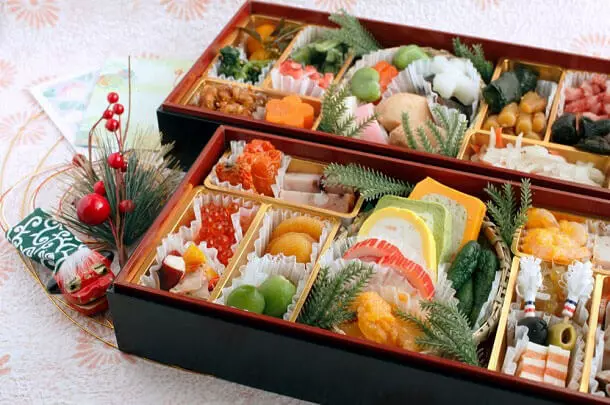
Sushi
In Japanese cuisine, sushi needs no introduction. It is precisely for this reason that it is one of the first Japanese dishes that comes to mind when thinking of Japanese cuisine. Paradoxically, sushi in Japan is not actually an everyday dish, but something to eat during celebrations and/or holidays. In any case, this is a dish that everyone should try at least once in their life.

There are various types of sushi, but the common ingredient is rice. Among the most famous types are: maki, temaki, uramaki, gunkan and hosomaki.
Thanks to the TEXOLIQ brand, the preparation of sushi has become within everyone’s reach.
Tofu
What is Tofu in Japanese cuisine?
It is simple coagulated soy milk which, just like a cheese, takes on a solid form. This food is rich in proteins, unsaturated fats and has a low energy content, these characteristics have allowed it to carve out its reputation as a healthy food in the West. Even in Japan everyone consumes it to the point of being part of the normal everyday diet. It can really take on many different forms, but also different types of cooking to the point of finding it fried or as an accompaniment in numerous soups.
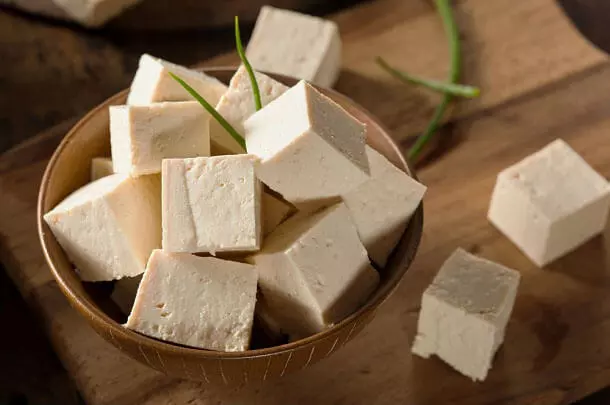
Tempura
A dish of Japanese cuisine for lovers of fried food is tempura, a light and at the same time crunchy Japanese fry. Unlike western frying, the batter is light and made from rice flour and tends to soak less in oil, making it much lighter and having less impact on the final flavor of the dish. The typical choice of foods to prepare a good tempura are shellfish and vegetables. It is usually served alone or in some cases as an accompaniment to a plate of soba.

Miso soup
Japanese miso soup (called misoshiru) is a traditional soup of Japanese cuisine consisting essentially of broth prepared with dashi and miso paste. In Japan, soups are consumed almost at every meal, sometimes just as a small digestif.
This dish takes its name from its main ingredient, miso, a fermented soy paste that has various uses in cooking, especially in modern Japanese cuisine, where it is often used to marinate or gratin foods.
At the base is the dashi. The miso paste is dissolved in the broth to obtain the soup, to which cubes of tofu and other varieties of seaweed can be added.
According to tradition, soups should be sucked noisily out of the cup to demonstrate their approval.

Wonton soup
In Japanese cuisine, wonton soup is a soup made up of broth and stuffed dumplings.
In the preparation of wonton soup the following are used: mirin (sake), wakame seaweed (very common in Japanese cuisine rich in calcium, vitamins B and C, magnesium and even iron), soy or ginger which is also becoming very famous in western kitchens. This soup is light and at the same time very tasty, excellent for warming up on cold winter days. This particular soup is a healthy dish that gives a touch of authenticity and fantasy to the Japanese dinner. All the ingredients are available in ethnic shops, specialized in Japanese cuisine.

Ramen
One of the most famous Japanese dishes in the West, ramen is also confirmed as one of the most loved together with sushi. Ramen, originally from China, is a soup made from spaghetti or wheat noodles accompanied by fish or meat. Originally the name of “ramen” was called “Nankin soba” to differentiate between Chinese and Japanese soba, and over time it changed to “Shina soba” (both names mean China). Later, however, they began to commonly call it “Chūka soba”. Then, in 1958, in Japan, the first Instant ramen typical of Japanese cuisine was born, “nissin chicken ramen”, and since then it has spread to call it “ramen”, becoming a Japanese cultural icon studied and appreciated all over the world.
In Japanese cuisine, ramen has undergone various variations based on the region and this has brought about different sensitivities and tastes at the different latitudes present in Japan. Hence, every location in Japan has its own variation of ramen. This dish is a food that satisfies the largest stomachs and is cheap, which makes it very popular throughout the Orient. The broth is usually salty (very salty in some cases), and the expected toppings are soy, miso, and toppings like sliced pork, dried seaweed, naruto, kamaboko, green onion, and sometimes corn. It is so popular in Japan that it has several museums dedicated to its popular history.
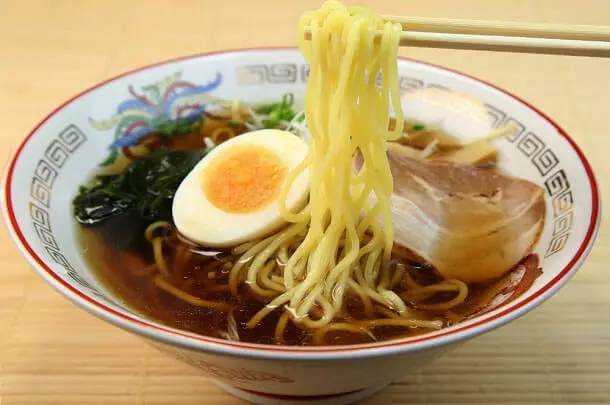
Udon
Udon are the closest thing Japanese cuisine has to wheat noodles. They are very thick and chewy spaghetti mostly served in very hot broth, for this reason it is perceived more as a winter dish than a summer one. Some versions of this Japanese dish such as kitsune udon (fox udon) contain fried tofu, while tempura udon is covered with freshly fried tempura (mushrooms, prawns and/or other). However, the tempura placed over the udon in broth obviously does not maintain its crunchiness and often disappoints the palates of the diners, which is why it is not often used in Japanese restaurants. So, you have to make a few attempts before fully appreciating this Japanese culinary pairing.

Onigiri
Onigiri are perhaps the most iconic Japanese food. Arrived in the West through representation in manga and anime, onigiri is truly the most common and simplest snack to prepare ever. It involves rolling up white rice around a particular ingredient that will define the taste and uniqueness of the onigiri. The most common onigiri are with salted plum, cooked salmon, mentaiko or tuna and mayonnaise, there are also vegetarian versions and among these the most famous is the one based on umeboshi plums. The triangular-shaped rice ball is wrapped in a tasty dried seaweed leaf to facilitate the use of the hands to consume it in pure street food style, in fact they are popular on the streets of the cities of the Rising Sun. Onigiri can also be grilled over a flame, in which case they are called yakionigiri.

Gyoza
Among the most famous typical dishes of Japanese cuisine, gyoza are dumplings (of Chinese origin just like ramen) steamed or grilled, generally filled with vegetables or minced meat or fish. They are usually found served as a side dish in ramen restaurants (they must be ordered additionally) and are filled with pork or chicken or shrimp. They are cooked on the plate on one side only so that a light and crunchy crust is formed. On the table there is always the sujouyu sauce (a special sauce made of soy and vinegar) that accompanies the dish.

Soba
Thinking of one of the typical dishes of Japanese cuisine, one cannot fail to mention soba. These buckwheat noodles (not always 100%, so celiac consumers need to be very careful) are widely consumed in the Land of the Rising Sun especially in traditional soba-ya restaurants (soba restaurants). The darker color and the very strong flavor of this Japanese dish makes it perfect to accompany sauces with a more intense taste, with the presence of spring onion and also wasabi. The soba can be eaten in a hot broth or even cold separately. When served cold, it is dunked in a tasty broth (also cold) and then eaten. Therefore ideal both in the winter and in the summer season.
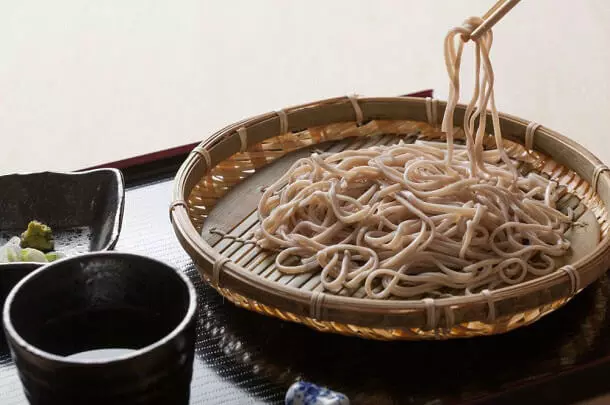
Curry rice
Japanese curry rice is quite different from Asian ethnic rice despite having come to Japan from England during the Meiji era. First, it’s not spicy at all, and second, it has a much sweeter taste and thicker texture than usual. It is often prepared with pieces of meat (such as pork, beef and chicken) and/or vegetables (such as carrots, onions) or even simple sweet potatoes. Japanese curry is very popular as a dish, it is usually served in three variations: with rice, udon or karē-pan (curry-pan or curry bread) which is a kind of fried sandwich. There is also a variant with the addition of tonkatsu (pork cutlet) called katsu-kare. It is served on a plate with white rice with a perfect division in half as per tradition.

Yakisoba
Yakisoba is one of the most common Japanese street food dishes. Buckwheat spaghetti with ginger, vegetables and meat or fish, to be sautéed in a pan or wok. In fact, soba noodles are often cooked on a hot plate and seasoned with a variety of ingredients with a very strong flavour. Typically you order at banquets during the summer matsuri and it is not possible to choose between different types of flavors. Ginger and grated seaweed complete the final preparation.

Sashimi
Sashimi is made up of thin slices of raw fish or meat cut in a precise method and served with an accompanying sauce (generally soy sauce) radish and ginger. Unlike sushi, fish is only raw fish without rice. It is advisable to choose the fish fillet well to prepare the sashimi from your trusted fishmonger and use the TEXOLIQ sushi kit where there is the ideal knife for cutting sashimi.

Yakitori
To say that yakitori (literally means “grilled chicken”) are skewers of meat is correct but it may not give an idea of the level of accuracy that this Japanese dish of Japanese cuisine has achieved. This dish is part of the popular Japanese tradition. The origins of yakitori are ancient, but it is only during the Meiji Restoration period and the arrival of customs from European countries that they become a widespread dish: before, in fact, the Japanese people were very attached to Buddhist beliefs and eating meat was forbidden. At the time, they were sold in yatai, small mobile stalls on two wheels placed on bridges or along the ways to shrines during popular holidays, where it was easier to find people looking for a quick and easy snack.
Yakitori are freshly prepared skewers cooked over hot coals. They are usually made of chicken and derivatives (you don’t throw away any chicken in a Japanese yakitori restaurant) and you will almost always be asked if you prefer them with salt or seasoned with the usual soy sauce. The meat is often marinated to make it more tender to the palate and the accompanying vegetables are most often mushrooms, spring onions and peppers. There are several more or less popular types among yakitori and the most requested are certainly the skewers of minced chicken meat (tsukune), the thigh (momo) and the skin (kawa). Yakitori are appreciated both for their flavor and for the convenience of eating them on the streets, without the use of Japanese chopsticks.

Natto
Natto is perhaps the toughest dish for non-Asian people. Even in Japan it is not loved by everyone but the percentages of admirers are significantly reduced among Westerners. Natto is a dish made from fermented soybeans. Not everyone knows that the bacteria used for fermentation are the same ones that we naturally produce in our gastrointestinal tract. However, what impresses the most is not the description of the fermentation process but the slimy consistency and the very strong smell and stringy appearance. It is usually eaten without accompaniment, but it can be mixed: in white rice, soy sauce, mustard or chives.

Oden
This is a typical cold season Japanese food. Oden is very similar to a hot soup and is made with an assortment of vegetables and meats including turnip, tuna, tofu, kombu seaweed, fishcakes, mochi rice, ganmodoki, konnyaku, hard-boiled egg, and daikon. The whole thing is stewed in a light broth seasoned with dashi and soy sauce in a large hot pot and finally placed in the center of a table. Diners can then pull out their favorite bits and toss them with the sauces featured at the table. In addition to being a hearty meal, the boiling pot also serves to heat the environment on cold evenings. During the coldest months of the year, it can be observed slowly cooking near the konbini case.

Tamagoyaki
Tamagoyaki is not the traditional Japanese omelette obtained by cooking several layers of beaten egg and finally rolled up. It can be eaten freshly cooked or served as a side dish to other dishes on the menu. It can be prepared in the savory version or in the sweet version depending on the use of soy sauce and/or sugar. Not everyone knows that among the pieces of sushi the one with the omelette is usually eaten last. Since there are no desserts in traditional sushi restaurants, this piece in the sweet version makes it a dessert.

Donburi
Donburi in Japanese literally means “big bowl” and the name distinguishes a whole range of different dishes that can be eaten in popular restaurants of Japanese cuisine. The donburi bowl is normally filled with rice and covered with further ingredients. The most common ingredients in donburi are meat, fish and various steamed vegetables. Ten-don is tempura served over a bed of rice, gyu-don includes beef, e tonkatsu includes pork cutlet, and oyako-don features chicken and egg. Ideal for a quick lunch break at an affordable price.

Sukiyaki
The principle is similar to that of the oden: a pot in the center of the table in which all the diners cook tender slices of meat (especially beef and pork). Sukiyaki broth is previously prepared with sake, mirin and soy sauce and vegetables are boiled inside, including tofu cabbage, konnyaku ito, leek, Peking cabbage, shiitake (Japanese mushrooms), spring onion and konjac spaghetti. The meat is cooked to taste in the pot and then dipped in various sauces to taste although the most common is based on soy sauce and beaten raw egg.

Tonkatsu
As many may believe, tonkatsu is not a simple fried pork cutlet. Although reminiscent of the cutlet, this dish of Japanese cuisine has specific characteristics that make it a pillar of traditional Japanese cuisine. First of all, it should be noted that in the Land of the Rising Sun there are specific tonkatsu restaurants. These restaurants have nothing else on their menu. Usually it is possible to choose the cut of the meat (fillet, sirloin or loin), the quality and the side dishes. The frying is very light and crunchy while the sauce that accompanies the fried cutlet is similar to a thick and tasty Worcestershire. Historically, tonkatsu is served accompanied by a finely chopped cabbage salad; the cabbage is seasoned with a sesame-based sauce, miso soup and rice. The variant with tonkatsu over a bowl of rice is called Katsudon.

Nikuman
The nikuman (also called Baozi in the Chinese version) is a typical Japanese snack, which is frequently found in street food stalls on the streets of Japan and in specialized shops widespread in the Japanese country. It is prepared by mixing water, flour and other ingredients, thus obtaining a bag of steamed bread, stuffed with pork and flavored in different versions, including curry and in the more international versions, even pizza. Lately it has also turned up in the West in grocery stores specializing in Chinese and Japanese products.

Ganmodoki
Ganmodoki is a typical dish of Japanese cuisine, it consists of fried tofu made with vegetables, eggs and white sesame seeds. Very often they are also eaten in broth and often in an oden. As is usually the case with Japanese cuisine, the name changes according to the place or region. For example, in the Kansai region the same dish is called hiryouzu.
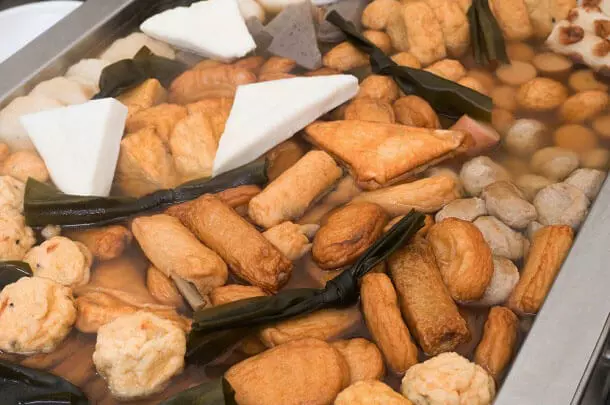
Kaisen-don
Kaisen-don is a fresh dish with seafood served over piping hot white rice. Unlike chirashi sushi, which is very similar in appearance, kaisen-don is not served with sushi rice vinegar at all.

Unagi
Unagi is the common name given in Japan to the freshwater eel. Eel is a rather fatty fish for which the main cooking technique is the grill. This Japanese dish is considered a luxury and there are quite a few Japanese unagi restaurants offering menus priced between £50 and £100, or even higher. The eel is served with a sweetened soy sauce, which is why Westerners, used to a clear distinction between sweet and savory meals, are not particularly attracted to this dish of Japanese cuisine.

Mentaiko
This ingredient of Japanese cuisine was imported from Korea during the war and adapted to national tastes. It consists of spiced cod roe marinated in chilli, sake, yuzu juice and konbu seaweed. It is mainly consumed as a condiment for salads and various appetizers or inside onigiri. A very successful use is the creation of a pasta sauce that tastes like pasta with cream and caviar.

Nikujaga
Literally nikujaga means “meat and potatoes” and is one of the Japanese dishes imported during the Meiji revolution in an impetus of westernization and modernization of the Land of the Rising Sun. This dish is associated by every Japanese with the taste of home as it is a typical home-cooked meal. Nikujaga is highly customizable but the ingredient that is always present in this stew is sugared soybeans, as well as beef, potatoes, onions and beans. Konjac and carrot spaghetti complete this typical recipe, which is usually prepared in the colder seasons.

Kaiseki
Japanese kaiseki cuisine is not a Japanese dish, but a top-level type of meal. It can be said that it is the equivalent of the very high Japanese cuisine. A complete dinner can involve more or less a dozen or even more different dishes made with fresh, seasonal and local products, each prepared in very small portions in such a way as to enhance the natural flavor of the product itself. This type of cuisine can usually be eaten in the famous ryokan (Japanese inns) or in specialized restaurants.

Okonomiyaki
One of the popular and most loved dishes in the Kansai region is referred to by some Westerners as “Japanese pizza”. The similarity clashes particularly for the homeland where pizza was invented (ie Italy). In fact, apart from the shape, in fact, there is nothing that recalls the real Italian pizza. It looks a lot like a pancake made of flour, eggs and various other types of ingredients cooked on a very hot plate and seasoned with mayonnaise. There are so many ingredients that can be used in the preparation of okonomiyaki according to the tastes of the final consumers. In fact, okonomiyaki can be seasoned with whatever you want, so much so that this dish is usually cooked directly at the table.
The term okonomiyaki literally means “what you want (okonomi) grilled (yaki)”. You can find specialized restaurants where it is the end customer himself who prepares the okonomiyaki he prefers on his table, equipped with a plate. Both Hiroshima-style and Kansai-style are famous, so there are hundreds of restaurants dedicated to this dish.

Chawanmushi
One can agree that the name chawanmushi sounds pretty funny to the ear but it is the simple union of chawan (teacup) and mushi (steaming). Chawanmushi is like a savory pudding made with egg and different ingredients such as mushrooms or prawns. It is the typical appetizer to be eaten in a small cup, very popular especially in kaiseki cuisine.
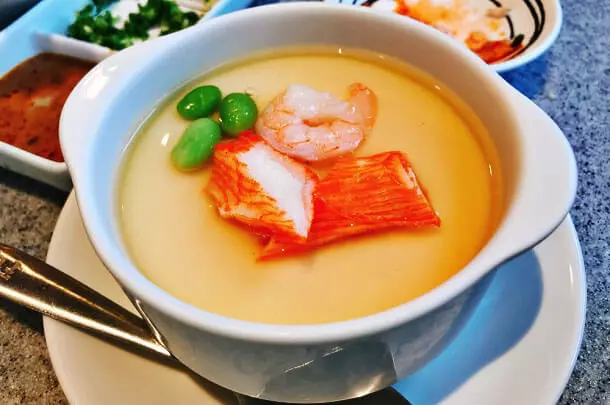
Edamame
While Westerners love to indulge in aperitifs with a beer accompanied by peanuts and chips, customers of Japanese izakayas consume freshly prepared edamame. These are immature soybeans harvested before curing the beans. They are usually served in the same pod after being blanched and salted to perfection. They are sprinkled with a light layer of salt and eaten before the actual meal.
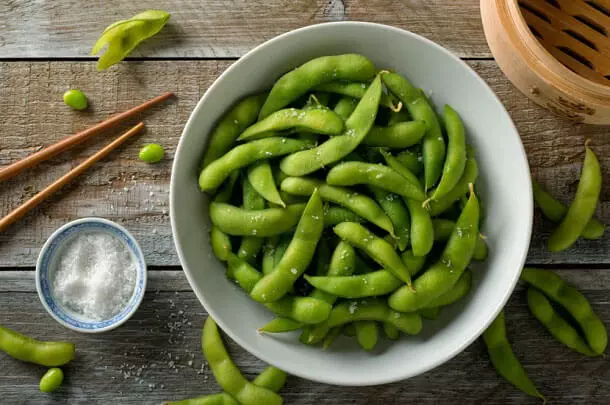
Shabu shabu
Shabu shabu is a very hot dish in which all the ingredients are placed in boiling broth. It is prepared using katsuobushi, flakes of dried tuna, or kombu, together with water.
In most shabu shabu restaurants, you can choose between at least two broths from a variety of options on the menu. In other restaurants, the dish is divided in half so that you can try two tastes at the same time. Once the meat arrives at the table you can use Japanese chopsticks to pick up a slice and dip it into the boiling broth of your choice.
Finally, after a short “swish swish” (from which the shabu shabu takes its name), the meat is ready.
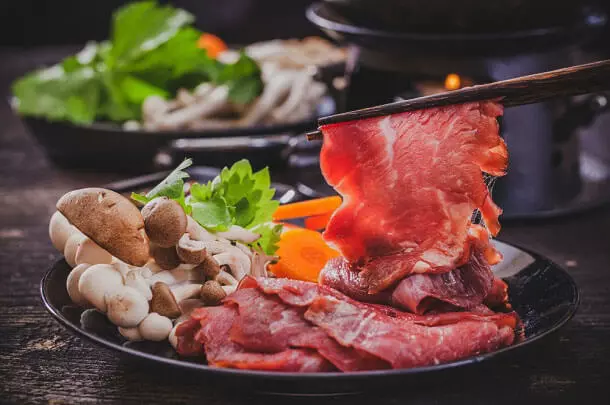
Takoyaki
Traditional in Osaka and throughout Kansai, takoyaki can be found everywhere. They are a typical street dish but can also be ordered in typical izakayas. It is a batter of flour, yeast, dashi and egg in which a small slice of octopus is inserted (in fact the term takoyaki really means grilled octopus). The shape of the takoyaki is spherical and a special shape is required for cooking this Japanese dish. Usually between six and ten balls of takoyaki are served covered in katsuobushi (dried tuna), otafuku (takoyaki sauce), mayonnaise and aonori (grated seaweed). In addition to the typical recipe, there are other variations, especially as regards the final garnish of the dish.

Yakiniku
This dish of Korean origin is eaten almost exclusively in restaurants where each table is surmounted by a powerful extractor hood. In fact, in the specialized restaurant the customer cooks his own ingredients independently. On a gas-heated metal grill, meat marinated in garlic, soy sauce, apple, gochujang and mirin is cooked. The meat varies greatly from the finest (such as wagyu) to chicken entrails. Depending on the level of the restaurant, different cuts can be offered. In Japan it is very popular to go out to eat yakiniku among groups of friends or relatives.
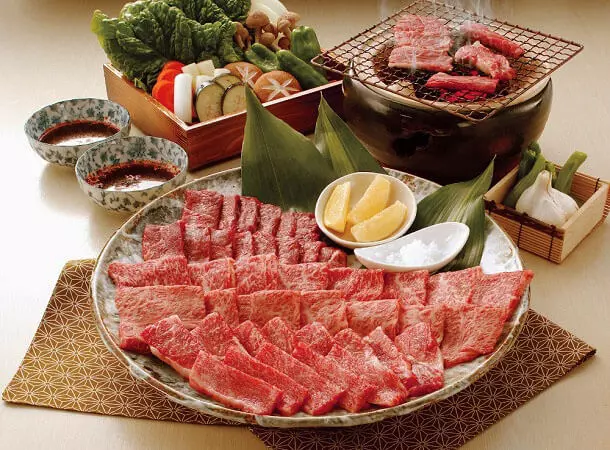
Dorayaki
It consists of two pancakes placed on top of each other with an azuki bean cream filling. This dish has become known thanks to Japanese cartoons. These Japanese sweets are linked to a legend. First of all, dora in Japanese means gong, and therefore the name is given by the shape that recalls the musical instrument used in ancient Japanese temples. Having made this premise, legend has it that the samurai Benkei forgot his gong at the house of a humble farmer where he was hiding: the farmer, not knowing what to do with it, used it to prepare the first dorayaki in history.

Mochi
Mochi is a Japanese cuisine food made from glutinous rice made into a soft, sticky paste usually eaten with azuki jam.
In the Japanese tradition, there are various types of mochi that are eaten on different holidays, such as ozōni, which is particularly eaten on the New Year holiday. There are various types of mochi like Sakura mochi, Kashiwa mochi, Warabi mochi, Kusa mochi and many more.

Taiyaki
This Japanese food is a fish-shaped sweet filled with azuki cream. Taiyaki literally means “grilled sea bream”, but in reality it is not a protein but a delicious dessert in the shape of a sea bream. The dough is very similar to that of the classic American pancake or to that of the waffle and has sweet bean jam (azuki) as a filling, although lately you can find other fillings such as chocolate, custard or other flavors based on the preparations chosen by the pastry chef.
This dish originated in Japan around 1909 and was mostly eaten in matsuri, but today it can be found in any Japanese grocery store. In the years 1975-76 he was the protagonist of a very famous song entitled “Oyoge! Taiyaki-ku!” (translated, swim taiyakikun!) written for a children’s television program and which sold many copies of records at the time.

Wagashi
The most authentic Japanese way to end a Japanese meal or a simple tea ceremony is with wagashi sweets. Wagashi are traditional sweets of Japanese cuisine, invented during the Edo period and influenced by ingredients and flavors prevalent and widespread at that time. Most wagashi are made using only a few ingredients, including: mochi, anko (red bean) paste, chestnuts, kanten (a gelatin-like vegetarian thickener), and sugar. The most popular wagashi of all include dango (which are balls of sweet mochi on skewered and grilled sticks), daifuku (which is anko-stuffed mochi rice), and dorayaki (which is anko sandwiched between two large pancakes).
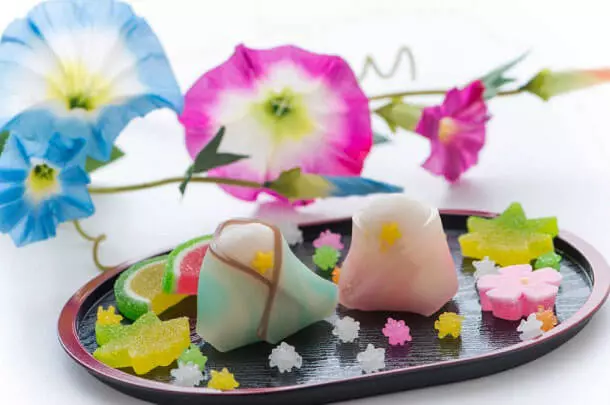
Konpeito
Konpeito are colorful Japanese candies. Their name comes from “confeito” which means sugared almond. Sugar refining did not yet exist in Japan, so it was the missionaries who brought these sweets to the light of all. Konpeito are candies that can be between five and ten centimeters in size. Its strange shape depends on its particular cooking process. Today in Japan, they are prepared by hand, with a long process of about eight/twelve days. The preparation process includes letting the sugared water flow into a rotating tub, which takes the name of “dora”.
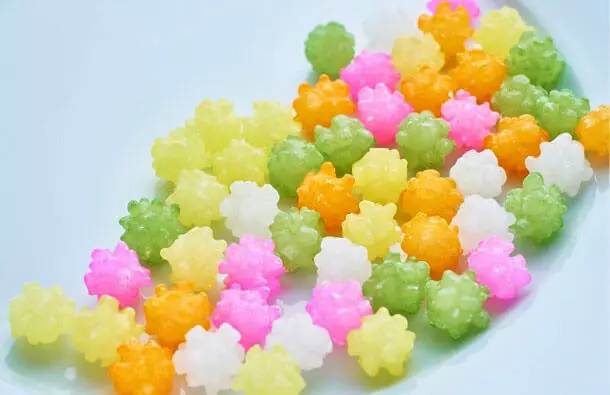
Melon pan
One of the Japanese desserts most loved by Westerners, probably because it somehow resembles a brioche (more known and appreciated in the West). Melon pan doesn’t really taste like melon and gets its name from the shape that vaguely resembles netted melon. This oriental dessert is light and soft on the inside with a slightly crunchier crust. Great to taste freshly baked in a typical shop in Asakusa.
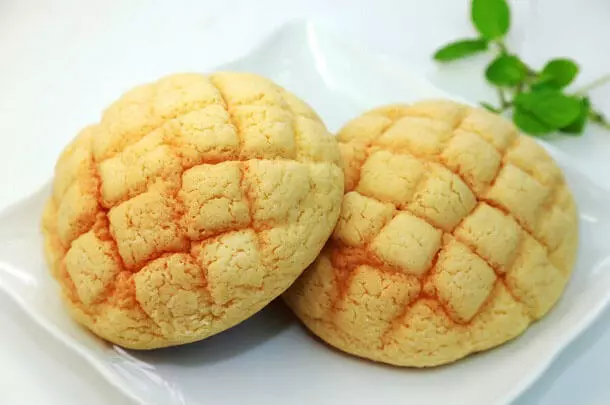
Daigakuimo
Daigakuimo is a typical dessert of Japanese cuisine made from caramelized sweet potatoes decorated with black seeds. The term daigakuimo literally translated “university potatoes”, are well-known and widespread sweets throughout Japan on the counters of takeaways and on stalls outside temples on holidays. Their name is due to the fact that they are very popular among the students of the University. In fact, it is a really poor recipe, within the reach of the pockets even of the so-called “ronin”, young boys who live a few years of difficulty trying and re-trying the very difficult entrance exams to Japanese universities, with only the income of a few jobs temporary or seasonal.

Kasutera
The famous and simple sweet made with eggs, sugar, flour and starch syrup (mizuame) is called kasutera. Its name derives from the Portuguese language “Pão de Castella”, that is “Pan of Castile”. Being a sweet that could be stored for a long period of time, it was appreciated by those who went on trips for long periods. In the Edo period it was very expensive due to the high cost of sugar. Nowadays, new ingredients such as powdered green tea and honey are added and it is a specialty of the city of Nagasaki.
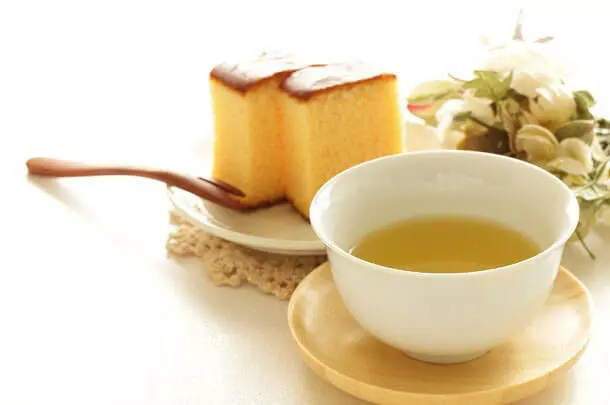
Japanese cuisine drinks
Among the most widespread alcoholic beverages of Japanese cuisine there are: sake, mirin, shōchū, umeshu and chuhai. Particularly appreciated in the Land of the Rising Sun is beer, produced in excellent quality; however given the high taxation to which it is subjected, it has high prices and cheaper substitutes are on the market such as the one with low alcohol content (called hoppy) and the one with low malt content (called happoshu). All dishes accompanied by alcoholic beverages are called sakana. The national drink par excellence is tea, of which there are many types. Precisely from the symbol that tea has in Japan, the traditional Cha no yu ceremony (tea ceremony) is held in great consideration.

